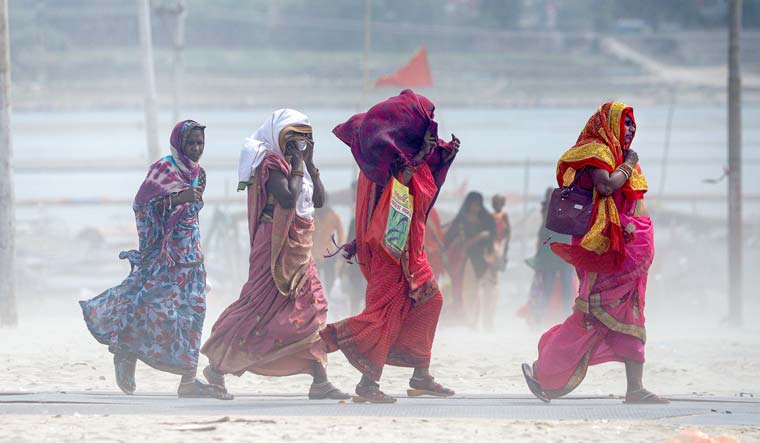Large swathes of India reeled from searing heat and stifling humidity on Monday with maximum temperatures soaring to 45 degrees Celsius, straining power grids and prompting health warnings from government agencies.
Authorities in Jharkhand suspended classes up to 8 due to the sweltering heat.
Intensely hot conditions are expected in east India until May 1 and the south peninsular region over the next five days, the India Meteorological Department (IMD) said.
The weather office issued a red alert, warning that extreme heat could scorch parts of Andhra Pradesh, Bihar, West Bengal and Odisha over the next two to three days. An orange warning is in place for parts of Telangana, Karnataka and Sikkim.
On Monday, temperatures shot up to 45.4 degrees Celsius (8.6 notches above normal) in Kalaikunda and Kandala, 45 degrees Celsius in Nandyal (Andhra Pradesh), 44 degrees Celsius in Sheikhpura (Bihar) and 44.8 degrees Celsius in Baripada (Odisha).
Heatwave to severe heatwave conditions prevailed in parts of West Bengal, Gujarat, Bihar, Sikkim, Odisha, Jharkhand, Kerala and Andhra Pradesh, the IMD said in a statement.
The threshold for a heat wave is met when the maximum temperature of a weather station reaches at least 40 degrees Celsius in the plains, 37 degrees in the coastal areas, and 30 degrees in the hilly regions, and the departure from normal is at least 4.5 notches.
A severe heat wave is declared if the departure from normal exceeds 6.4 notches.
The IMD said people in areas where a red alert has been declared could develop heat illness and heatstroke and suggested taking extreme care.
In orange-alert areas, there is a likelihood of heat illness in people who are either exposed to the sun for a prolonged period or doing heavy work.
The Met office said high humidity could add to people's inconvenience in Assam, Tripura, Gujarat, Tamil Nadu, Puducherry, Goa, Kerala and Karnataka during the next five days.
The ongoing heatwave spell is the second this month. Heatwave conditions have been prevailing in Odisha since April 15 and in Gangetic West Bengal since April 17, according to the Met office.
The IMD also said warm night conditions are likely in east Uttar Pradesh and Karnataka over the next five days. High night temperatures are considered dangerous because the body doesn't get a chance to cool down.
Increasing nighttime heat is more common in cities because of the urban heat island effect, in which metro areas are significantly hotter than their surroundings.
Amid the prevailing but weakening El Nino conditions, the IMD had earlier warned of extreme heat during the April-June period, coinciding with the seven-phase Lok Sabha elections.
Lakhs of voters had to cope with the searing heat when they stepped out to exercise their franchise in the second phase of the Lok Sabha elections on April 26.
Voting to elect representatives from 94 constituencies in 12 states will take place on May 7.
The Met office has said four to eight heatwave days are expected in different parts of the country in April against a normal of one to three days. Ten to 20 heatwave days are expected against a normal of four to eight in the entire April-June period.
The areas and regions predicted to witness a higher number of heatwave days are Madhya Pradesh, Gujarat, Odisha, Andhra Pradesh, Madhya Maharashtra, Vidarbha, Marathwada, Bihar and Jharkhand. Some places may record more than 20 heatwave days.
The intense heat could strain power grids and result in water shortages in parts of India.
Global weather agencies, including the IMD, are also expecting La Nina conditions to develop later in the year.
El Nino conditions -- periodic warming of surface waters in the central Pacific Ocean -- are associated with weaker monsoon winds and drier conditions in India. La Nina conditions -- the antithesis of El Nino -- lead to plentiful rainfall during the monsoon season.
In a mid-April update, the IMD said India would experience above-normal cumulative rainfall in the 2024 monsoon season with La Nina conditions, expected to set in by August-September, being the dominant factor.
The monsoon is critical for India's agricultural landscape, with 52 per cent of the net cultivated area dependent on it. It is also crucial for replenishing reservoirs critical for drinking water apart from power generation across the country.



